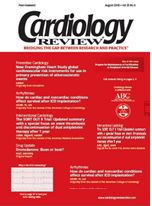Do ACE inhibitors have antiarrhythmic properties?
This issue of Cardiology Review features an important study in the combined arrhythmia and hypertension sections, where Dr. Pierre-Frederic Keller and colleagues from Canada report that angiotensin-converting enzyme inhibitors may have potent antiarrhythmic properties, especially with regard to preventing atrial fibrillation. Dr. Joseph T. Dell’Orfano comments on this study and the need for additional data from a prospective trial.
A combined article in the diabetes and heart failure sections by Drs. Joshua Barzilay and Richard Kronmal correlates the level of fasting blood glucose with the subsequent development of congestive heart failure in 829 diabetic adults 65 years of age or older. A positive relationship was found, even in the absence of coronary artery disease. In her commentary, Dr. RoseMarie Pasmantier points out that this evidence speaks strongly for the presence of diabetic cardiomyopathy, which she believes is an underdiagnosed condition.
In the stroke section, the risk of stroke in relation to the serum homocysteine concentration was evaluated by Dr. Hiroyasu Iso from Japan in a prospective case-control study of 11,614 subjects without prior history of stroke or coronary artery disease. Japanese men and women with higher homocysteine levels had higher stroke rates. Can the stroke rate be reduced by treatment with folic acid? This is just one of the intriguing questions posed by Dr. Robert A. Levine in his commentary.
In the hypertension section, Dr. Giuseppe Schillaci and associates from Italy determined the prognostic significance of finding the metabolic syndrome (a cluster of cardiovascular risk factors closely linked to insulin resistance) in 1,742 hypertensive patients without overt cardiac disease. The patients were followed for a mean of 4.1 years (range 1—10.5), and the cardiovascular event-free survival rate was significantly lower in the subgroup with the metabolic syndrome. Dr. Wendy S. Post comments on these findings.
In a combined article in the lipid disorders and coronary artery disease sections, Drs. John W.G. Yarnell and Christopher C. Patterson from the United Kingdom compared the predictive values of plasma lipids and three inflammatory/hemostatic coronary artery disease risk factors. The study population consisted of 4,860 men, of whom 525 had a subsequent cardiac event. Their provocative conclusions are discussed by Drs. Rhondalyn C. McLean and Roger S. Blumenthal in their commentary.
Finally, Dr. Stephen P. Glasser presents another installment in his series on clinical research.
